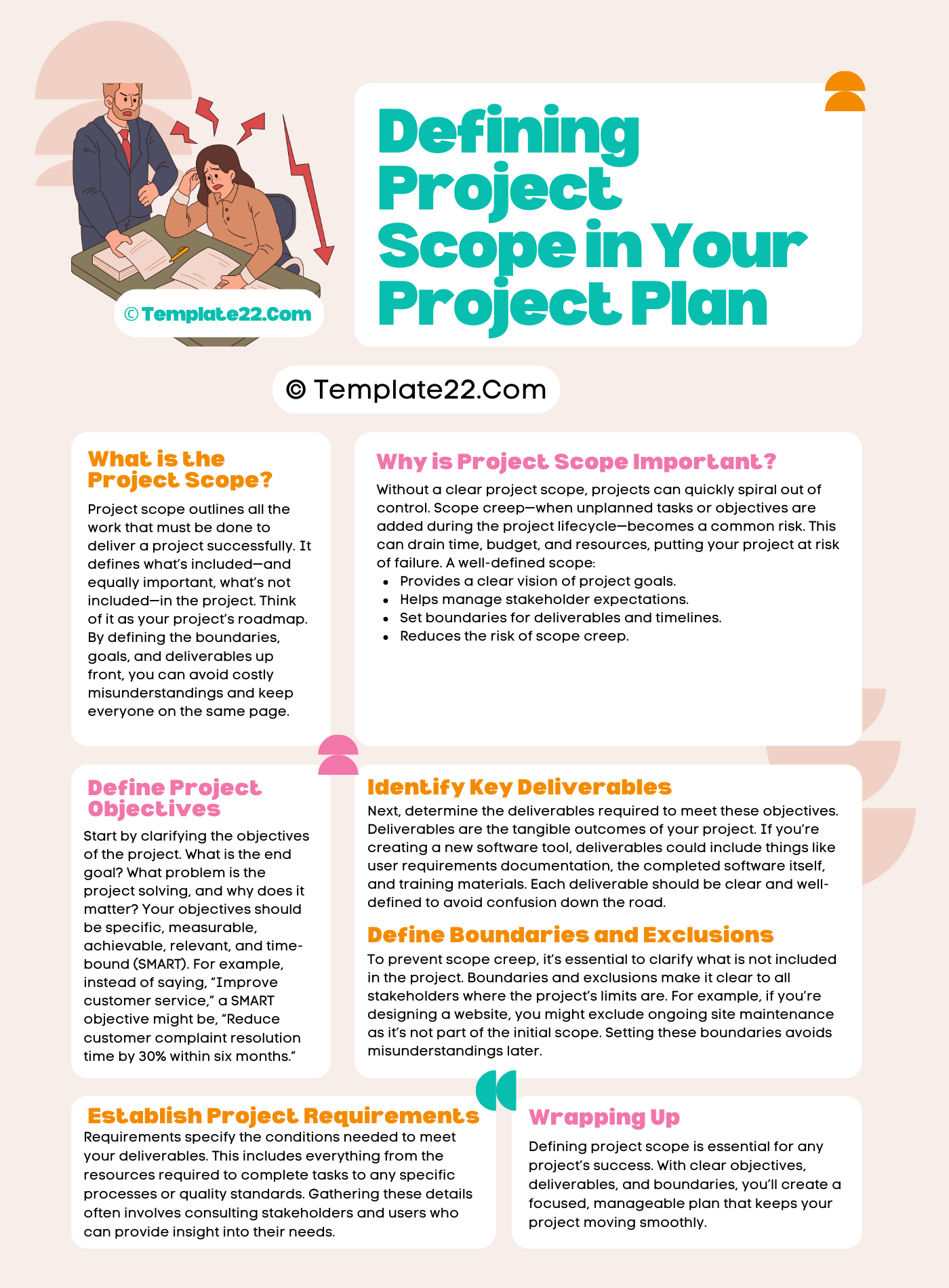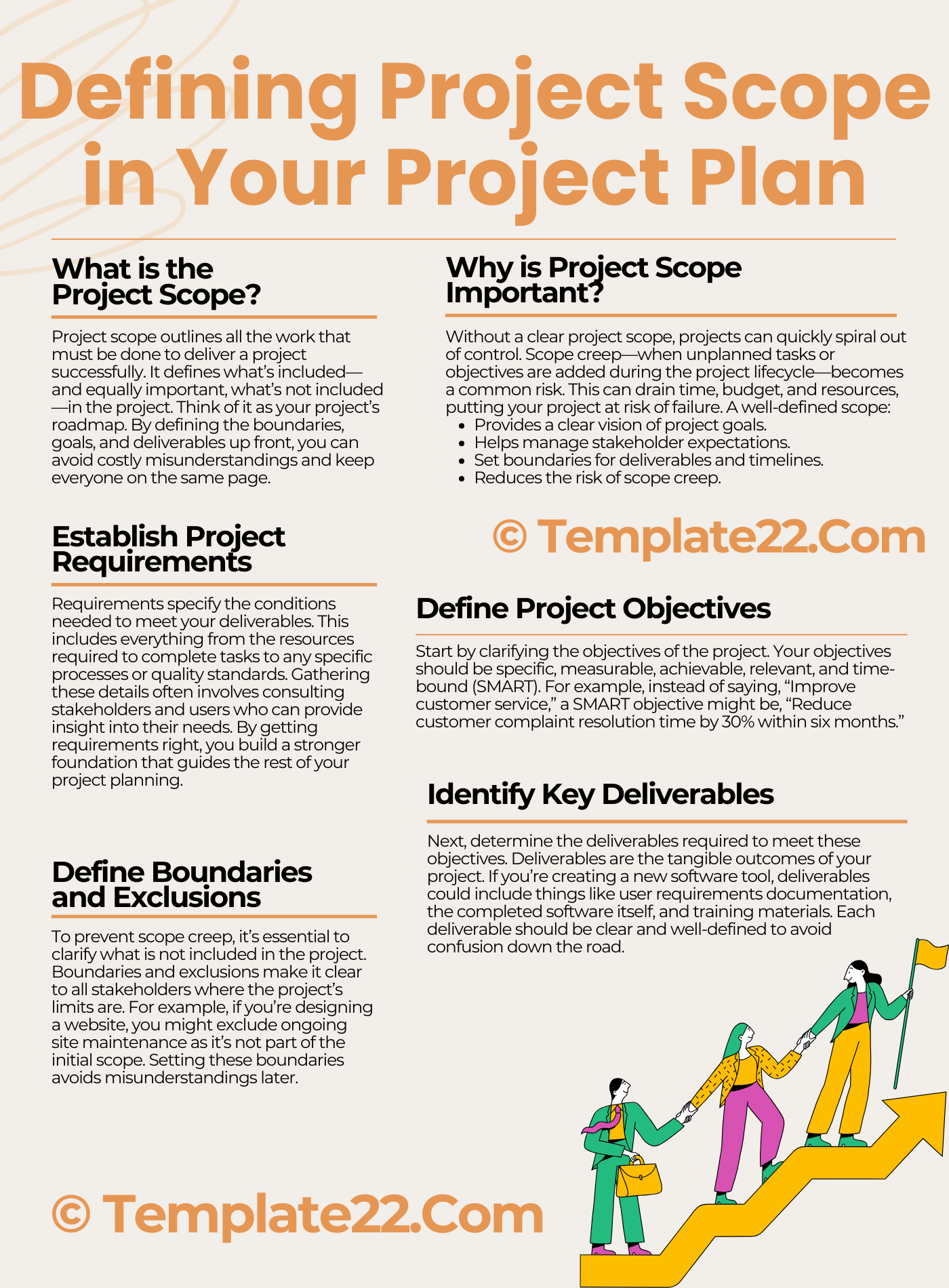 Project scope is the foundation of any successful project plan, providing clarity and direction from day one. When well-defined, it guides the project team, aligns stakeholder expectations, and helps keep the project on track and within budget. Let’s break down how to define your project scope effectively so you can set your project up for success.
Project scope is the foundation of any successful project plan, providing clarity and direction from day one. When well-defined, it guides the project team, aligns stakeholder expectations, and helps keep the project on track and within budget. Let’s break down how to define your project scope effectively so you can set your project up for success.
1. What is the Project Scope?
Project scope outlines all the work that must be done to deliver a project successfully. It defines what’s included—and equally important, what’s not included—in the project. Think of it as your project’s roadmap. By defining the boundaries, goals, and deliverables up front, you can avoid costly misunderstandings and keep everyone on the same page.
2. Why is Project Scope Important?
Without a clear project scope, projects can quickly spiral out of control. Scope creep—when unplanned tasks or objectives are added during the project lifecycle—becomes a common risk. This can drain time, budget, and resources, putting your project at risk of failure. A well-defined scope:
- Provides a clear vision of project goals.
- Helps manage stakeholder expectations.
- Set boundaries for deliverables and timelines.
- Reduces the risk of scope creep.
CLICK HERE TO DOWNLOAD 300+ PROJECT MANAGEMENT TEMPLATES & DOCUMENTS IN EXCEL
3. Steps to Define Project Scope
Step 1: Define Project Objectives
Start by clarifying the objectives of the project. What is the end goal? What problem is the project solving, and why does it matter? Your objectives should be specific, measurable, achievable, relevant, and time-bound (SMART). For example, instead of saying, “Improve customer service,” a SMART objective might be, “Reduce customer complaint resolution time by 30% within six months.”
Step 2: Identify Key Deliverables
Next, determine the deliverables required to meet these objectives. Deliverables are the tangible outcomes of your project. If you’re creating a new software tool, deliverables could include things like user requirements documentation, the completed software itself, and training materials. Each deliverable should be clear and well-defined to avoid confusion down the road.
Step 3: Establish Project Requirements
Requirements specify the conditions needed to meet your deliverables. This includes everything from the resources required to complete tasks to any specific processes or quality standards. Gathering these details often involves consulting stakeholders and users who can provide insight into their needs. By getting requirements right, you build a stronger foundation that guides the rest of your project planning.
Step 4: Define Boundaries and Exclusions
To prevent scope creep, it’s essential to clarify what is not included in the project. Boundaries and exclusions make it clear to all stakeholders where the project’s limits are. For example, if you’re designing a website, you might exclude ongoing site maintenance as it’s not part of the initial scope. Setting these boundaries avoids misunderstandings later.
Step 5: Outline Project Assumptions and Constraints
Assumptions and constraints are factors that could impact your project. Assumptions are things you believe to be true for planning purposes, such as the availability of team members or specific technologies. Constraints are limitations, such as budget caps or tight deadlines. By outlining these, you add context to the scope and reduce the likelihood of surprises during the project.
4. Documenting the Project Scope
Once the scope is defined, it’s time to document it. The Scope Statement is a crucial part of your project plan, summarizing all the details above. Make sure it’s accessible to all team members and stakeholders. This document serves as a reference throughout the project lifecycle, ensuring everyone understands and adheres to the agreed-upon scope.
CLICK HERE TO DOWNLOAD 300+ PROJECT MANAGEMENT TEMPLATES & DOCUMENTS IN EXCEL
5. Revisiting and Revising the Scope
The project scope isn’t static. Regularly revisit it during the project, especially if circumstances change or new information comes to light. By revisiting the scope, you can make necessary adjustments before they become issues, helping the project stay on track and within bounds.
Wrapping Up
Defining project scope is essential for any project’s success. With clear objectives, deliverables, and boundaries, you’ll create a focused, manageable plan that keeps your project moving smoothly. Remember, your project scope is your compass—use it wisely, and it will guide you through even the most complex projects.
